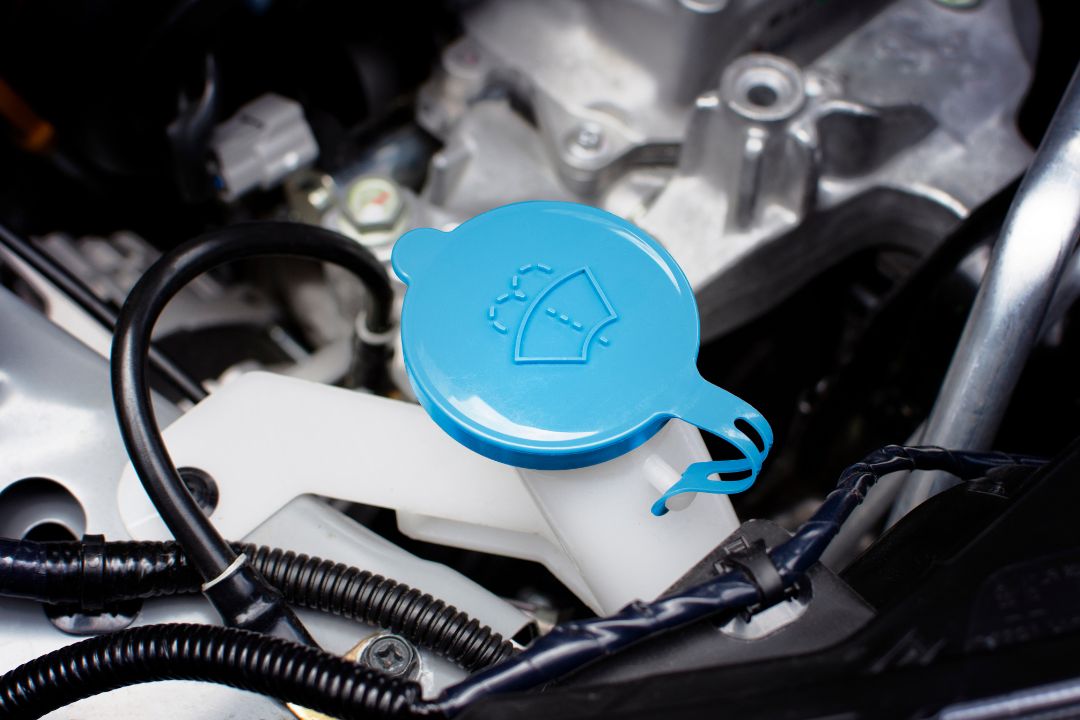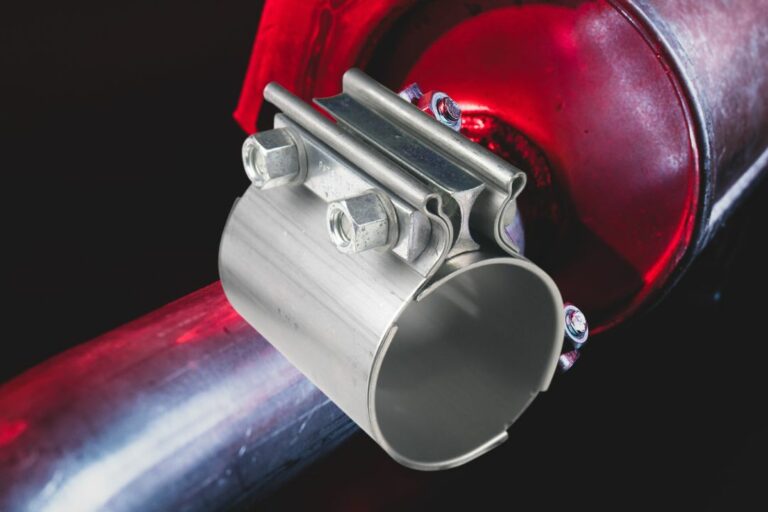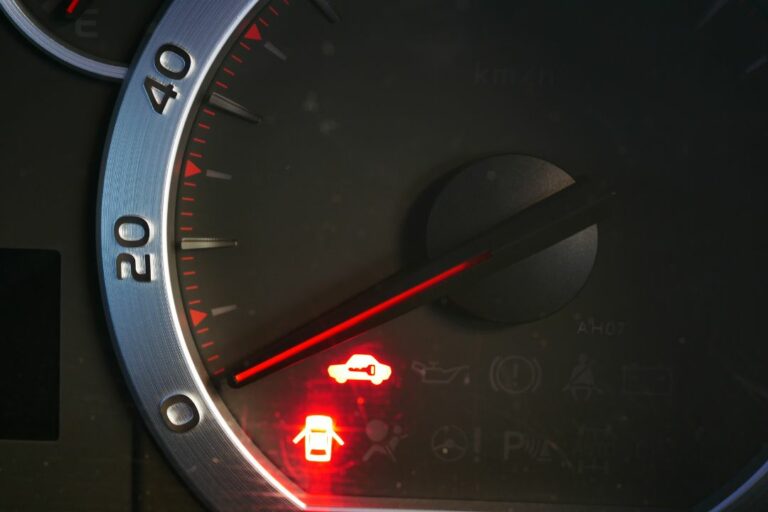Windshield Washer Fluid Leaking From Bottom (Guaranteed Fix!)

You’re driving down the road on a rainy day, trying to keep your windshield clean and clear for safe visibility.
Suddenly, you notice something unusual – Windshield Washer Fluid Leaking From Bottom of your car! This can be a frustrating and potentially dangerous problem if left unchecked.
Not only does it lead to inefficient cleaning of the windshield but also damage to other parts of your vehicle. If that blue liquid is dripping from under your vehicle, don’t wait until it’s too late- take action now!
In this article we will explore everything you need to know about windshield washer fluid leaks including potential causes, how much repairs may cost, warning signs and most importantly how to fix them with ease so that you can drive safely even in spring storms.
Understanding Windshield Washer Fluid Leaks:
If you are experiencing windshield washer fluid leaks from the bottom of your vehicle, it can be indicative of a problem with your washer fluid reservoir.
Before trying to diagnose and fix the issue yourself, it’s important to understand what causes these leaks.
The washer system is comprised of several parts which include the reservoir, pump and filler neck.
The reservoir holds the water/liquid mixture that is pumped through your windshield wipers to clean the glass.
When there is leakage around or near this area, it could indicate that one or more of these components may have cracked or broken.
One common reason for windshield washer fluid leaks is due to a crack in the plastic material used for making the reservoirs.
Another possible cause could be a damaged grommet or O-ring found inside or around this part.
Additionally, if there are any issues with how tightly these parts were attached together during installation, they might become loose over time and result in leaking.
In some cases, users may also experience leaks when driving on rough terrain as vibrations can loosen some parts like rubber hoses leading into their tanks.
By understanding what causes windshield fluid leaks from the bottom of your vehicle you will have better knowledge on how best to address this problem in order to maintain unobstructed visibility while driving.
What is Windshield Washer Fluid?
First things first, let’s understand what windshield washer fluid actually is. Windshield washer fluid, also known as windshield wiper fluid or just simply “washer,” is a liquid used to clean the windshield while driving.
It typically contains a mix of water and alcohol (like methanol) along with other detergents and additives to help remove dirt, grime, bugs, and other debris from your windshield.
Having enough washer fluid on hand is an essential part of ensuring good visibility while driving. In fact, many states require that drivers have an ample supply of washer fluid before they can pass a safety inspection.
So if you notice your reservoir is low or leaking from the bottom, it’s important to address the problem as soon as possible so you can keep your windshield clean and clear all season long!
How to Identify Windshield Washer Fluid Leaks?
If you suspect that your windshield washer fluid is leaking, the first step is to identify the source of the leak. Here’s how to do it:
- Check the location of the leak: The most common location for a washer fluid leak is at or near the bottom of the reservoir. Look underneath and around its circumference.
- Check for visible cracks: Inspect both inside and outside parts thoroughly for any visible cracks, especially around threaded areas.
- Check for grommet or o-ring damage: If there are no visible cracks, check if any rubber sealing parts like grommets or o-rings are damaged.
- Conduct a water test on your car’s plastic parts: Fill up your entire reservoir with plain water and park your vehicle overnight in order to evaluate if there are any leaks in plastic pieces such as hoses, fender liners etc.
These steps should help you identify where exactly on your system a leak may be coming from. Once identified, you can move on towards fixing it accordingly as well!
What Causes Windshield Washer Fluid Leaks?
| Causes | Solutions |
|---|---|
| Damaged washer fluid reservoir | 1. Inspect the reservoir for cracks or leaks. Replace if necessary. |
| Loose or damaged washer fluid hose | 2. Check the hose connections and tighten or replace damaged hoses. |
| Faulty washer fluid pump | 3. Test the washer fluid pump and replace if it is not functioning properly. |
| Cracked or damaged washer fluid nozzles | 4. Inspect the nozzles for cracks or damage. Replace if needed. |
| Improperly installed or missing gaskets | 5. Check the gaskets around the reservoir, pump, and nozzles. Reinstall or replace as necessary. |
| Clogged or blocked washer fluid lines | 6. Clear any clogs or blockages in the washer fluid lines using compressed air or a suitable cleaning agent. |
There can be several reasons why your windshield washer fluid is leaking from the bottom of your vehicle. Some common causes include:
- Cracked or damaged reservoir: Over time, the plastic material of the windshield washer fluid reservoir may crack or become damaged, leading to leaks.
- Faulty or damaged pump: The pump is responsible for supplying the fluid to the wiper nozzles, and a faulty or damaged pump can cause leaks.
- Damaged hoses: The hose that carries washer fluid from the reservoir to the nozzle may also become cracked or broken due to wear and tear.
It’s important to identify what’s causing the leak in order to properly fix it. Checking all parts of your system, including inside fenders and around headlights, can help pinpoint the exact location of leakage.
If you notice any cracks or other signs of wear and tear on any parts of your windshield washing system, they should be replaced immediately.
Diagnosing Windshield Washer Fluid Leaks:
Signs of Windshield Washer Fluid Leaks
If you suspect a windshield washer fluid leak, there are several signs to look out for. One of the most obvious signs is a puddle of blue liquid around the bottom of the reservoir or under your vehicle.
Another sign could be that your windshield wipers are not working correctly or leaving streaks on your windshield.
You may also notice a decrease in the amount of fluid in the reservoir and have to fill it up more frequently than usual. When checking for leaks, inspect all parts of the system carefully from inside and outside.
Other indicators include cracked plastic components, damaged rubber grommets or o-rings, and loose or broken bolts/nuts securing the washer supply line. If you see any cracks on hose inlet/outlet threads near pump motor headlight/fender area then chances are that they need repair too.
In summary, if you notice any unusual issues with your windshield wiper system – including low fluid levels after refilling it once every week – it’s best to have it checked by an expert as soon as possible.
Don’t ignore these problems as this can cause severe damage to critical mechanical components like motors/pumps that would require costly repairs/replacements later down the road!
Causes of Windshield Washer Fluid Leaks:
There can be several causes of windshield washer fluid leaks. One of the most common reasons is a cracked or damaged reservoir, which can happen due to wear and tear over time. Another likely cause could be a faulty pump that fails to contain the flow of liquid properly.
Location of Windshield Washer Fluid Leaks:
To diagnose the location of the windshield washer fluid leak, start by checking around the bottom of the reservoir for any signs of fluid.
This is a common area for leaks, especially if there is damage to the plastic or rubber components or if the reservoir has been overfilled.
Another potential location for leaks is around the filler neck or supply line. Check these areas closely for cracks, loose connections, or damaged grommets.
If you notice any issues in these parts, it’s best to replace them with new ones rather than trying to repair them.
It’s also important to check around the motor and pump assembly located inside or near the reservoir. Look for signs of moisture on and around these parts as they could indicate a problem with either one.
If you’re having trouble locating where your windshield washer fluid is leaking from, it may be best to take your vehicle to a professional mechanic who can use specialized tools and experience to identify and fix problems like this efficiently.
Remember that fixing windshield washer fluid leaks should be done as soon as possible since they can lead not only to inefficient cleaning but also other serious issues in your car such as overheating and exhaust damage.
Fixing Windshield Washer Fluid Leaks:
If you’ve identified that your windshield washer fluid is leaking from the bottom, there are a few steps you can take to fix the problem.
Before proceeding with any repairs, it’s important to first check the level of fluid in the reservoir and inspect its condition.
If the reservoir is cracked or damaged beyond repair, it will need to be replaced. To replace the reservoir, follow these steps:
- First, remove any parts obstructing access to the windshield wiper/washer system.
- Next, locate and remove any bolts or screws securing the old reservoir in place.
- Once removed, disconnect all hoses and wiring connections attached to the old reservoir.
- Install a new washer fluid reservoir in its place and reattach all hoses and wires accordingly.
- Fill up with windshield washer fluid until reaching an appropriate level.
If only specific parts of your motor or grommet are damaged or cracked rather than replacing everything you can also find replacement pumps/motors separately online.
Keep in mind that repairing leaks for older car models might require rubber filler which may not come together with other parts so we recommend checking if they’re available before attempting repairs but do note that some users quote cheaper prices when using alternative products like rubber o-ring store gaskets instead of original ones sold by dealerships.
It’s always important to pay extra attention around fenders as this area often gets hit by salt-brine solutions during winter times creating rust problems further down line.
Checking the Level of Washer Reservoir:
If you suspect that your windshield washer fluid is leaking from the bottom, the first step is to check the level of your washer reservoir.
You can find this reservoir typically near the engine bay or under the front fender.
To check it, locate the filler cap and remove it. Check if there is any liquid inside and what condition it’s in.
If you notice that the level is low or empty, fill it with fresh water or a suitable washer fluid according to your vehicle owner’s manual.
It’s important to make sure that you don’t overfill it past its maximum level as this could cause leakage from around parts like rubber grommets/oring threads at the bottom of plastic reservoirs.
Checking for cracks or damage in any area around your washer system also need some attention.
It’s possible that a cracked reservoir will leak fluid on to surrounding components including headlight assemblies which could be expensive problems if not fixed quickly so pay close attention to these areas as well while checking for leaks.
Inspecting the Condition of Reservoir:
To inspect the condition of your reservoir, start by visually examining the bottom of the reservoir for any signs of cracks or damage. Look closely around the filler neck and supply line to make sure there are no leaks in those areas.
Next, check the rubber grommet on the bottom of the reservoir where it connects to the washer pump motor. If this grommet is cracked or worn out, it can cause leaks around the motor area.
You should also check for any loose connections between parts or hoses inside and around the reservoir. Sometimes leaks can be caused by these connections coming loose over time.
If you find that your reservoir is damaged beyond repair, then replacing it with a new one may be necessary in order to fix your windshield washer fluid leak problem.
Always use high-quality replacement parts when fixing any issues with your vehicle’s systems to ensure optimal performance and safety on the road.
Steps to Replace the Pump:
If you have diagnosed the issue with your windshield washer fluid leak and found out that the pump is the culprit, here are some steps to replace it:
- Locate the windshield wiper fluid reservoir. It is usually located in the engine compartment on either side of the car’s front fender area.
- Drain all of the washer fluid from the reservoir using a hand pump or by disconnecting one of its hoses.
- Remove any plastic fasteners or screws that hold down any covers near or around the reservoir to gain better access to it.
- Disconnect all wires and hoses connected to your current pump and remove it from its location by gently shifting it back and forth until it gets loose enough for you to remove with your hands.
- Take off any rubber grommets or O-rings that came along with your old pump as they could be reused to install a new one.
- Replace old parts like these with replacements if necessary, then insert a new windshield washer pump into position before securing everything down tightly again through re-connection of all wires/hoses previously disconnected during removal process earlier on
- Refill your windshield washer reservoir with clean water (or mixture according to manufacturer instructions) until full while keeping an eye on leakage around threads – tighten fill cap securely after filling so no more leaks occur in future
Fixing Windshield Washer Fluid Leaks in Audi A4:
If you have a windshield washer fluid leak in your Audi A4, it’s important to address the issue as soon as possible.
One of the main causes of this issue is a crack or hole in the reservoir, which can be identified by checking for puddles of washer fluid around the bottom of the reservoir.
To fix this issue, you’ll need to replace the windshield washer reservoir with a new one. This can be done by first locating and removing the supply lines that run from the reservoir to the wipers and headlights.
Then, remove any bolts or screws that are holding the reservoir in place and carefully lift it out of its location.
Next, transfer any necessary parts such as rubber grommets or O-rings over to your new reservoir before placing it back into position. Secure all bolts and screws tightly before reattaching all supply lines.
Finally, refill your new windshield washer fluid container with washer fluid until it reaches an appropriate level.
It’s crucial to check for leaks after installation since improper sealing could lead to future problems down the line.
With proper installation and maintenance practices followed closely, keeping your car should not pose further concerns relating to windshield washers leaking from their plastic container at bottom areas around fenders or front headlight posts!
Windshield Washer Fluid Leak Repair Cost:
When it comes to repairing windshield washer fluid leaks, the cost can vary depending on several factors. Some of the relevant factors include:
- The type of vehicle you have
- The location of the leak in the system
- The severity of the leak
On average, you can expect to pay around $145-$150 for repair costs related to windshield washer fluid leaks. However, this is just an estimate and your actual costs may be higher or lower depending on your specific situation.
If you suspect that there is a problem with your windshield washer fluid reservoir or system, it’s important to get it checked out as soon as possible.
Delaying repairs could lead to more serious issues down the line, such as inefficient cleaning of your windshield or even damage to other parts of your car.
In some cases, if the reservoir is already cracked or damaged beyond repair, you may need to replace it altogether instead of trying to repair it.
This can add additional costs to your repair bill but will ensure that your windshield washing system operates effectively and efficiently.
Conclusion
If you notice windshield washer fluid leaking from the bottom of your vehicle, it’s important to take action to diagnose and fix the problem.
Ignoring the issue can lead to a range of problems including inefficient cleaning of your windshield, overheating of your car, and potentially even exhaust damage.
To diagnose and fix windshield washer fluid leaks, start by checking the level in the washer reservoir and inspecting its condition.
If you notice cracks or other signs of wear, it may be time to replace it with a new one. Checking for leaks around the reservoirs is also important as this could indicate a problem with parts such as grommets or o-rings.
Repair costs for windshield washer fluid leaks typically range from $145-$150 depending on factors such as the location of the leak and whether any components need to be replaced.
Overall, keeping your windshield washing system well-maintained is key to maintaining visibility while driving – especially during spring storms when visibility can be particularly challenging.






